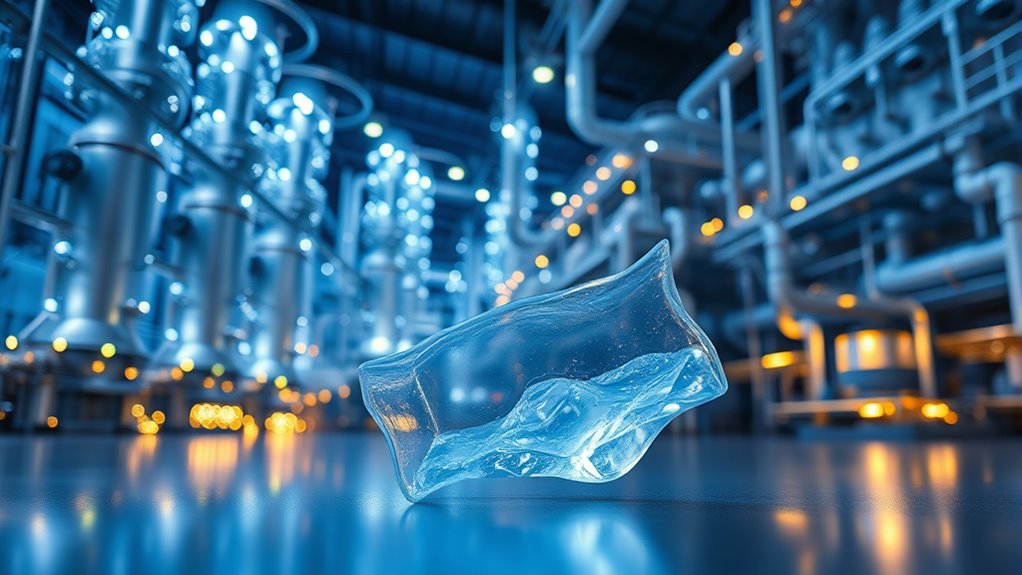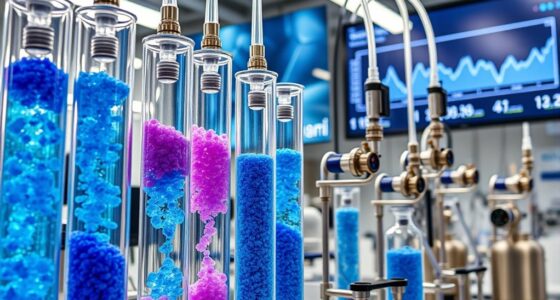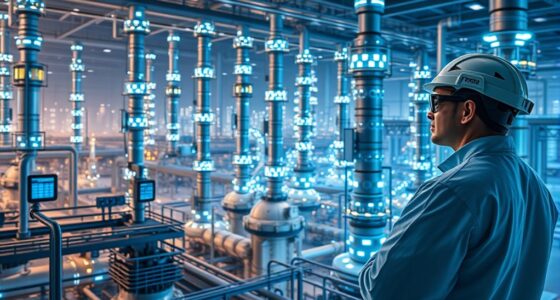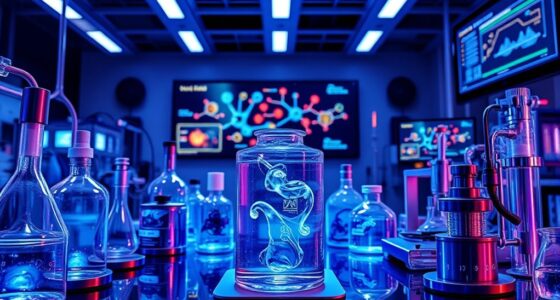Chemical recycling is gaining momentum by breaking plastics down into their basic monomers, allowing you to reuse materials almost like new. This process uses advanced techniques such as depolymerization and purification to guarantee the recovered chemicals are pure and ready for polymerization. It keeps plastics in a continuous cycle, reducing waste and reliance on fossil fuels. If you keep exploring, you’ll discover how ongoing innovations make these technologies more efficient and environmentally friendly.
Key Takeaways
- Chemical recycling breaks plastics into monomers, enabling high-quality reuse and supporting a circular plastics economy.
- It employs techniques like depolymerization and solvolysis to convert polymers into their basic chemical building blocks.
- Feedstock purification ensures recovered monomers are free of contaminants, maintaining material quality for new plastic production.
- Advances in catalytic and purification technologies improve process efficiency, reduce costs, and minimize environmental impact.
- Chemical recycling addresses plastic waste challenges by enabling sustainable, endlessly recyclable materials and reducing reliance on fossil fuels.

Chemical recycling offers a promising solution to plastic waste by breaking down polymers into their basic chemical building blocks, which can then be reused to produce new plastics. This process hinges on the ability to efficiently carry out polymer degradation, transforming complex polymer chains into simpler monomers. Unlike mechanical recycling, which often degrades the quality of plastics, chemical recycling aims to recover virgin-like materials, making it a crucial component in creating a circular economy for plastics.
Chemical recycling breaks polymers into monomers, enabling the production of high-quality, reusable plastics in a circular economy.
When you consider polymer degradation, you’re fundamentally breaking the long-chain molecules into smaller, more manageable units, often through methods like pyrolysis, solvolysis, or depolymerization. These techniques facilitate the breakdown of diverse plastics, such as PET, PE, and PP, into their respective monomers, enabling their reuse in manufacturing.
Once the polymers are broken down into monomers, the next critical step is feedstock purification. This process ensures that the recovered chemicals are free of contaminants, impurities, or residual additives that could compromise the quality of the new plastic produced. Purification is indispensable because even trace impurities can impact the polymerization process, leading to inferior material properties.
You, as a recycler or manufacturer, need high-purity feedstocks to produce consistent, high-quality plastics. Feedstock purification involves removing dyes, fillers, or other incompatible substances, often through filtration, distillation, or other refining techniques. Achieving a high level of purity not only improves the efficiency of the subsequent polymerization but also aligns with industry standards for recycled plastics.
The importance of effective polymer degradation and feedstock purification can’t be overstated. They’re the backbone of chemical recycling’s success, ensuring that broken-down plastics can re-enter the supply chain as high-quality raw materials. By controlling these processes, you help close the loop on plastic use, reducing reliance on fossil fuels and cutting down on landfill waste.
Additionally, advances in catalytic processes and purification technologies are continuously improving the efficiency, cost-effectiveness, and environmental footprint of chemical recycling. As you stay informed about these innovations, you’ll be better equipped to adopt sustainable practices that support a circular economy.
Ultimately, mastering polymer degradation and feedstock purification means you’re contributing to a future where plastics are endlessly recyclable, minimizing environmental harm while maximizing resource efficiency. Recognizing the role of beneficial ingredients like collagen and hyaluronic acid in skin care, although unrelated, underscores the importance of purity and quality in processes involving delicate materials.
Frequently Asked Questions
How Does Chemical Recycling Compare to Mechanical Recycling Efficiency?
Chemical recycling often surpasses mechanical recycling in efficiency because it produces higher chemical purity of the recycled material. You’ll find that process optimization plays a key role here, allowing chemical methods to break plastics down more completely into monomers.
This results in fewer contaminants and better-quality recyclables. While mechanical recycling is simpler and faster, chemical recycling offers a more thorough, sustainable solution, especially for complex or contaminated plastics.
What Environmental Impacts Does Chemical Recycling Have?
You should know that chemical recycling impacts the environment by reducing chemical waste and pollution. It helps control pollution by breaking plastics down to monomers, making recycling more efficient and less harmful.
However, it can also use significant energy and potentially release toxic emissions if not managed properly. Overall, chemical recycling offers environmental benefits but requires careful pollution control to minimize its ecological footprint.
Are There Safety Concerns With Chemical Recycling Processes?
Imagine a busy chemical plant, where safety is your shield against unseen hazards. You must conduct thorough hazard assessments and follow strict safety protocols to prevent accidents during chemical recycling.
These processes involve potentially volatile substances, so you need vigilance and proper training. By prioritizing safety measures, you protect yourself, workers, and the environment from risks like chemical spills or exposure, ensuring the process remains secure and responsible.
What Types of Plastics Are Suitable for Chemical Recycling?
You should know that suitable plastics for chemical recycling often include those with clear plastic identification codes like PET and HDPE, which are easier to process.
However, recycling challenges arise with mixed or contaminated plastics, making it harder to break them down efficiently.
How Scalable Is Chemical Recycling Technology Globally?
This challenge is huge, but chemical recycling’s scalability depends on your efforts. You can make it work globally by improving economic feasibility through technological advances and policy incentives that encourage investment.
While current systems aren’t yet widespread, ongoing innovation suggests it could transform waste management worldwide. With concerted effort, chemical recycling might just revolutionize how we handle plastic waste, making it scalable enough to meet global demands.
Conclusion
Chemical recycling is like revealing a secret door to a sustainable future, turning plastic waste back into valuable monomers. By embracing this innovative process, you help reduce pollution and conserve resources, much like restoring a damaged masterpiece to its original beauty. As technology advances, your efforts can drive real change, making plastic waste a thing of the past. Together, you can be the catalyst for a cleaner, greener planet—breaking down barriers and building up a better world.









